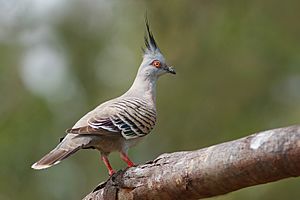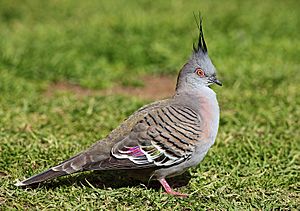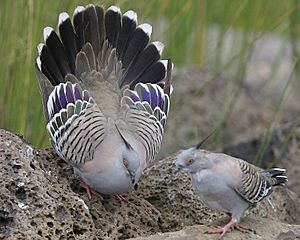Crested pigeon facts for kids
Quick facts for kids Crested pigeon |
|
|---|---|
 |
|
| Conservation status | |
| Scientific classification | |
| Genus: |
Ocyphaps
|
| Species: |
lophotes
|
The crested pigeon (Ocyphaps lophotes) is a type of bird that lives in most parts of mainland Australia. You won't find them in the far northern tropical areas. This pigeon is special because it has a cool, spiky crest on its head. Only two Australian pigeon species have an upright crest: the crested pigeon and the spinifex pigeon. The crested pigeon is bigger than the spinifex pigeon. Sometimes, people also call the crested pigeon a "topknot pigeon."
Contents
How They Are Classified
Scientists group living things into categories. This helps us understand how different species are related. The crested pigeon was first described in 1822 by a scientist named Coenraad Jacob Temminck. It is the only species in its group, called Ocyphaps. This group was created by George Robert Gray in 1842.
There are two main types, or subspecies, of the crested pigeon:
- O. l. lophotes: This type lives across the southern parts of Australia.
- O. l. whitlocki: This type is found in central and northern Western Australia. It was named after F. Lawson Whitlock, who collected many bird specimens in those areas.
What They Look Like
Crested pigeons are about 30 to 34 centimeters (12 to 13.6 inches) long. Their feathers are mostly grey, with hints of brown and green. They have a thin, black spike of feathers on top of their heads. This crest stands up straight when they run. The skin around their eyes is a bright orange color.
Their wings have black stripes and look shiny, almost like bronze. The main flight feathers have colorful areas of brown, purple, blue, and green. Young birds have duller colors and their wings don't have the bronzed look yet. It's very hard to tell if a crested pigeon is male or female because they look exactly the same.
When a crested pigeon gets scared and flies away, its wings make a very clear whistling sound. This sound comes from the way air moves over a special feather on their wings.
Where They Live
Crested pigeons live in open grasslands with some trees. You can find them in both the countryside and in cities. They are also seen near rivers, in gardens, on farms, at sports fields, and on golf courses.
Their homes have spread a lot since people started farming in Australia. They used to live mostly inland and in Western Australia. Now, they have adapted to farm areas, often eating grains. They even eat a plant called Echium plantagineum, which is a weed.
How They Behave
The most unique thing about crested pigeons is the loud whistling sound their wings make when they take off. This sound might help protect them. It could draw the attention of predators to the birds flying away, keeping the birds on the ground safer. It also acts as an alarm call for other pigeons.
When these birds land, their tails point upwards. Their flight looks similar to that of a spotted dove. Crested pigeons are very social birds. They often gather in flocks of different sizes. They are also quite friendly when they are around humans.
Breeding
Crested pigeons can breed all year round, but they usually do it more often in warmer months. When a male wants to attract a female, he does a special mating dance. He bobs his body up and down. As he bobs, he opens and closes his wings like a fan. He also makes a soft hooting sound that matches his bobbing.
If the female is interested, she will stay still as the male comes closer. Then, they will try to mate. Crested pigeons usually build their nests in shrubs or trees. Their nests are simple platforms made of twigs. They lay two oval-shaped, white, shiny eggs. The eggs usually hatch about three weeks after they are laid. Both the mother and father pigeon take turns sitting on the eggs to keep them warm.
See also
 In Spanish: Paloma bronce crestada para niños
In Spanish: Paloma bronce crestada para niños





